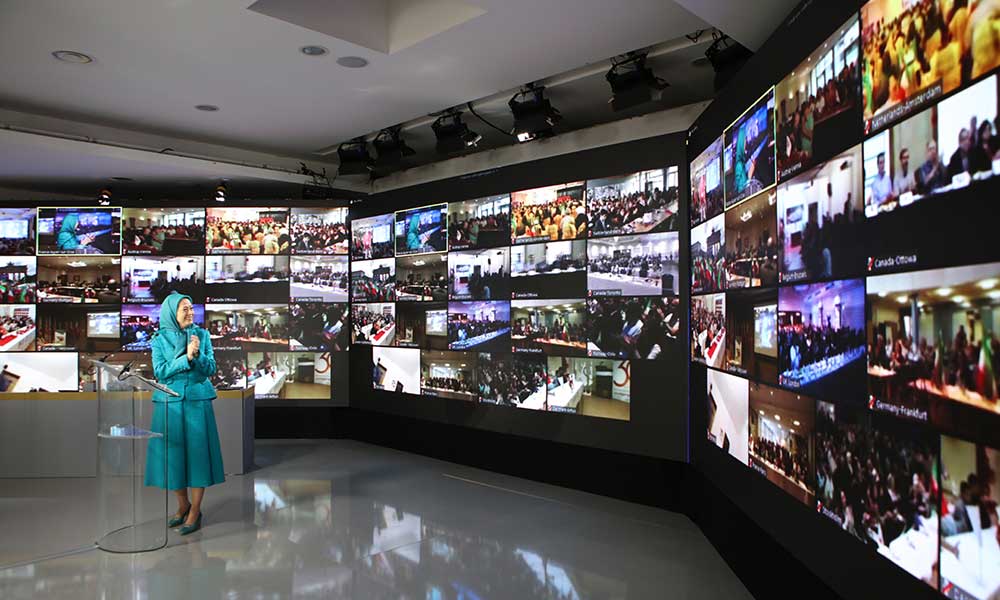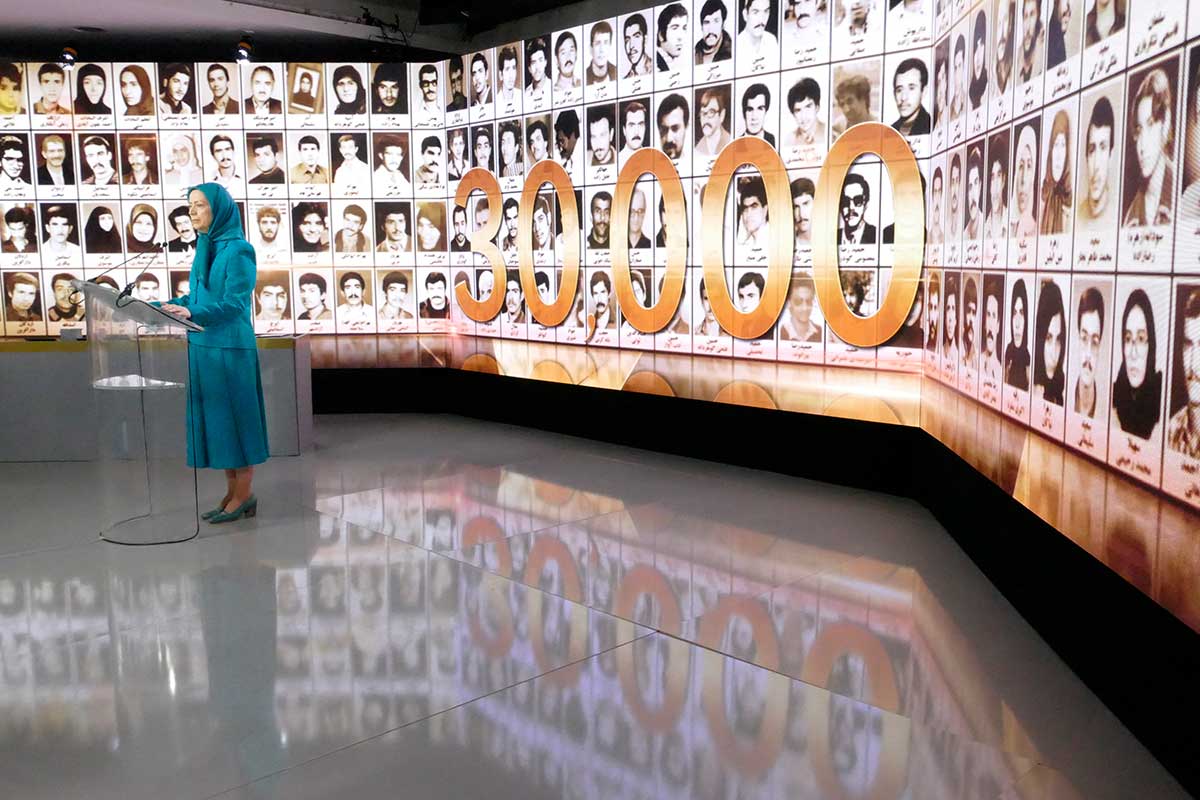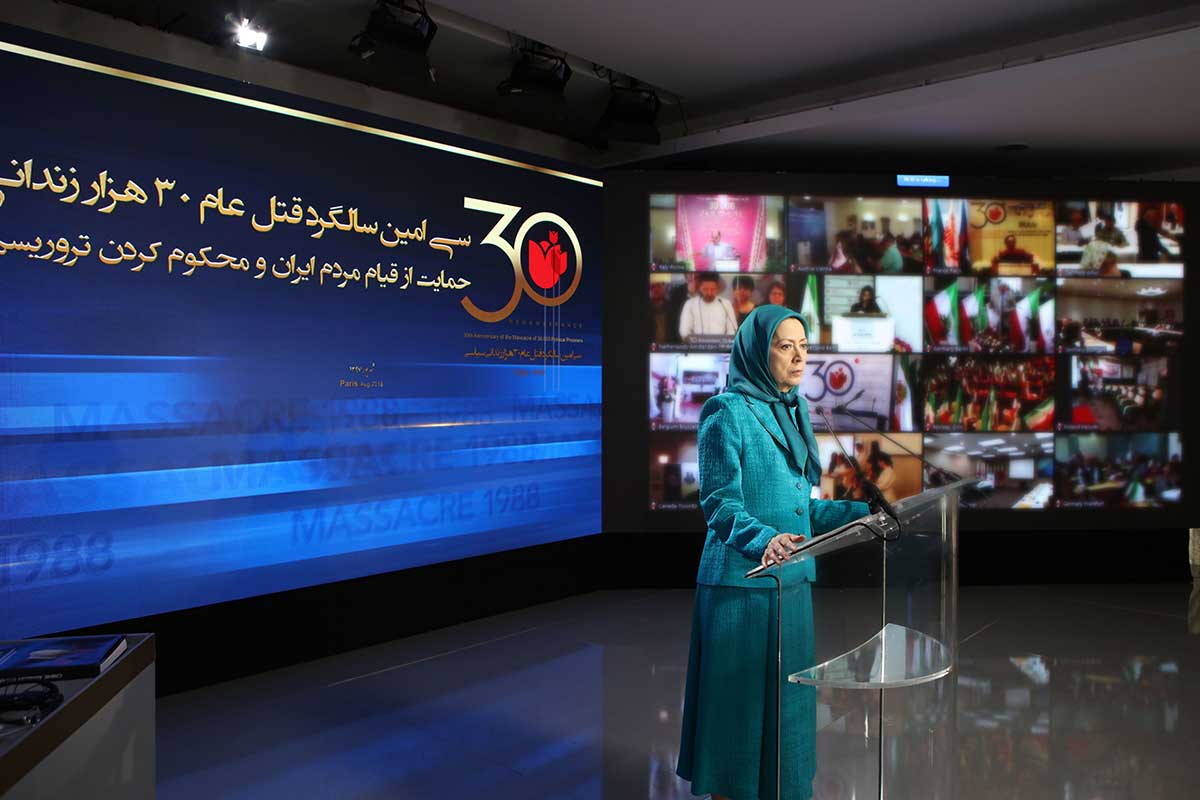Maryam Rajavi: Massacred heroes inspire protesters in revolting cities

Iranian communities’ global conference upholds 30th anniversary of the massacre of 30,000 political prisoners
A global video conference was held by Iranian communities on Saturday, August 25, 2018, to commemorate the 30th anniversary of the massacre of 30,000 political prisoners in Iran upon Khomeini’s decree for the genocide in 1988. The conference connected 20 cities in France, Germany, Britain, the Netherlands, Sweden, Norway, Denmark, Finland, Switzerland, Italy, Austria, Romania and Canada. A number of political dignitaries attended and addressed the conference where members and representatives of Iranian communities in Europe and Canada participated and delivered speeches. A number of eyewitnesses to the massacre and former political prisoners also testified at this event.
The conference started with remarks by Maryam Rajavi, honoring the heroes of 1988 and elaborating on their impact as an inspiration to the steadfastness of the organized Iranian Resistance for freedom and nationwide uprisings in Iran. Following is the full text of her remarks:
Distinguished personalities, dear guests,
Families of martyrs,
Sisters and brothers who have spent long years under torture in the dungeons of the Shah and the clerical regime,
Friends of the Iranian Resistance who have joined us today in France, Germany, Britain, the Netherlands, Sweden, Norway, Denmark, Finland, Switzerland, Italy, Belgium, Austria, Romania, and Canada,
I salute you all.
Thirty years have passed since the massacre of 30,000 political prisoners in Iran, but the mullahs could not conceal their blood-drenched epical resistance. Neither could their international appeasers undermine this incident in favor of the Iranian regime.
Today, those massacred heroes are not physically among us. The locations of their graves are not known and the list of their names is a secret. Speaking of their stories is forbidden and inquiring about their fate is a crime. Their song, however, continues to resonate in our hearts and minds.
On the 30th anniversary of this unforgettable epic, let us rise and honor the memory of the 30,000 red roses of the Iranian Resistance by a minute-long applaud.
According to the information compiled and published by the People’s Mojahedin Organization of Iran in a book entitled, Crime Against Humanity, our sisters and brothers were executed in 110 Iranian cities in a matter of a few months in 1988.
Now, those fameless towns have turned into hubs of uprisings, and those subdued cities have turned into hotbeds of revolt.
Let us look at Gohardasht of Karaj as an example. Thirty years ago, the resistant political prisoners in this city were lined up in long queues and led to corridors where they were hanged from the gallows. Three weeks ago, however, Gohardasht of Karaj turned into a battle field where courageous youth and resistance units waged an uprising.
In Shapour-e Jadid of Isfahan, in Shahinshahr, in Izeh, Dezful and Ahvaz, in Malayer, Baneh and Orumiyeh, in Zahedan and Bandar Abbas, and in Kazerun and Arak, people still remember the heroes who were hanged here and there from the gallows.
They remember their cause and why they sacrificed their lives, and why they persevered in defending their principles to the end.
The town of Aran in Kashan well remembers her child, Dr. Mansour Paydar, who used every opportunity to treat the poor and the destitute free of charge. He was arrested on his way to join the National Liberation Army and was executed in 1988.
Shahroud remembers Mahmoud Hassani who wrote a poem in prison: “At nights, when you see a glowing comet in the sky, remember the blazing flames who were extinguished in the cold nights of Evin.”
Shiraz remembers Fatemeh Zare’ii, the PMOI’s candidate for the first parliamentary elections in Iran. Mahidasht of Kermanshah remembers Daryoush Reza’ii who escaped the torture chambers of Dizelabad Prison, but was rearrested and executed in 1988 along with another PMOI prisoner from Ilam, Behzad Pour Nowrouz.
Isfahan remembers Fariba Omoumi. Astara remembers Mohammad Reza Saradar Rashti, and Rezvanshahr remembers Houriyeh Ramezani Nejad.
Mahallat bears lots of memories from Parviz Salimi; Qom remembers Effat Assadi; Saveh remembers Azar Kowsari; Boroujerd remembers Jamshid Assadi, and Lahijan bears memories of Mohammad Sami’zadeh. Khoy remembers Ashraf Mo’ezzi, and Naghadeh remembers Bahman Shakeri who was popular among both Kurdish and Turkish compatriots.
And Masjid Soleiman is never going to forget Ali Salehi, as Izeh remembers Nahid Kaykavous Nejad forever.
These names and memories have become eternal in the historic conscience of our society, lending a restless spirit of resistance and revolt to our cities and villages, inspiring the ultimate freedom of our homeland, Iran.
Former political prisoners have frequently told me that the brave PMOI prisoners chose Massoud Rajavi, the leader of the Iranian Resistance, in the most difficult and intolerable conditions when their choices and loyalty to their cause were being put to test. Those brave souls looked into the eyes of their torturers and interrogators and hailed Massoud Rajavi, or kissed the gallows in his name.
Without doubt, they had a message by repeating this most forbidden name of our time. Their message to the generations succeeding them was: O’ you, the young men and women, who hear our unfinished stories, you should undertake the path and the cause of Massoud Rajavi! The path of struggle for a society devoid of oppression and exploitation, devoid of suppression and tyranny, and devoid of ignorance and deception. This path and this cause are translated into the sacred word of freedom.

Dear friends,
In a verdict which constitutes the most irrefutable document on this genocide, Khomeini issued the order for the massacre and wrote in his own handwriting, “Those who continue to persist on their positions of hypocrisy in prisons across the country are considered as Mohareb (the enemy of God), punishable by death.”
The question is, what was the position they persisted on and why did Khomeini ruthlessly sentence them to death? What was their crime?
Their crime was standing up for freedom of the people of Iran, standing up against suppression of all freedoms, standing up against starvation of people, and standing up against destruction of Iran.
They executed the prisoners for their beliefs. This is an incredible catastrophe but this is what the inhuman clerical regime is all about. Their reaction to dissent, even inside prisons under their own control, is mass executions.
This is what the mullahs’ theocracy is all about. Any protest and any legitimate demonstration is repressed by detention and torture of participants.
In the uprisings last December and January, what was the protesters’ demand and what did they do wrong to be tortured to death? The bodies of a number of them were handed over to their families, telling them that they had committed suicide while in detention.
This is what the velayat-e faqih regime is about. It commits the crime and yet blames the victims of torture and massacre as culprits and criminals.
In the face of such a monster, is it right to give in, or to stand up, resist and fight back?
Where can you find a dictator that does not accuse the people’s just and legitimate resistance of terrorism, or who does not try to get rid of freedom lovers and opponents by accusing them of violence? Indeed, which dictator, tyrant or despot has given up on his crimes by silence and surrender of his victims?
Those who dress down freedom fighters and dissidents for getting tortured or executed, and blame protesters and the oppressed people for getting suppressed, they echo the hypocrite mullahs.
Dear friends,
The 1988 massacre is a major demarcation between the people of Iran and their enemies, separating them into two opposing fronts. There are those who try to hush up the massacre, seeking not only to defend the masterminds and perpetrators of this crime, but to fend off the haunting specter of freedom, popular sovereignty and overthrow of the clerical tyranny.
The so-called reformists, or the regime’s proponents who were totally rejected in the course of the recent uprisings, are still trying to find a way out for the velayat-e faqih but the massacre of 1988 has unraveled their schemes.
The people of Iran ask them why did they conceal the massacre? What were they doing and what were their roles as this massacre was being carried out? And why are they silent, now?
The truth is that the resistance of the massacred prisoners has posed a great challenge to the regime’s factions and their accomplices. At the same time, such steadfastness has been the dignified answer of the prisoners to the homicidal Khomeini who had left them with only two options: Surrender or die!
They sacrificed their lives but sowed the seeds of rising and revolt.
Thirty years on, the dispute continues to be over adherence to this ideal and resisting for it, an ideal which is today being espoused by the resistance units inside Iran. They are called the forces of overthrow. As Massoud Rajavi has pointed out, “The genuine response, and the essential and real answer, have always been and will continue to be in waging a fierce battle at the highest possible magnitude, such that it would escalate through resistance units, lead to the National Liberation Army, and shatter the troops of the anti-human enemy.”
Fellow compatriots and dear friends,
The clerical regime is beleaguered by the eight-month-long uprisings, by the growing role of the PMOI and resistance units in organizing and leading the revolts, and by the consequences of a plummeting and drowning economy. To break out of this deadlock, the mullahs sought to target the Resistance’s gathering in Paris on June 30 by a terrorist explosion.
In March, they had tried another terrorist scheme against the Iranian Resistance in Albania. And just in recent days, the mullahs’ intelligence and terrorist activities against the PMOI in the U.S. were revealed after two of their agents in that country were arrested.
These efforts and plots were foiled, of course, and the regime suffered their consequences. And once again, it became evident that the murderers of 30,000 political prisoners will stop at nothing to confront their alternative. It was also proven that terrorism is inherent to the clerical regime.
There is hardly any place left in the world which has remained immune to the regime’s terrorism. Tajikistan, Afghanistan, Azerbaijan, the Arab countries, and even Europe and the U.S.
This week too, the clerical regime’s cyber terrorism was also identified and banned. This is the system which engaged in large scale misinformation campaigns. The regime has been spending exorbitant sums of money from the Iranian people’s wealth to slander the Iranian Resistance and disseminate false information against it. The regime’s criminal network also seeks to disrupt safe communications and prepare the grounds for terrorist operations. This network must be shut down altogether.
The mullahs were under the illusion that they could exterminate the resistance movement by massacring its political prisoners, by prolonged suppression, and by demonization campaigns but they failed in their efforts.
Today, the mullahs’ president Hassan Rouhani pleas to the public to ignore the PMOI’s calls urging them to take to the streets. The regime’s experts say, “A third factor has entered the ring, robbing us before our own eyes of our most pivotal asset and the state’s means of power, namely, ‘our popular support…’ And this third factor is at work, deploying its levers, ‘the resistance units,’… to set fire to the state’s fundamental asset which are the young generations of this land.”
In reality, the main predicament the mullahs have to deal with today is their democratic alternative. They have actually lost hope in finding a solution to the crucial problems they face. So, they just try to postpone the development which would ultimately lead Iran towards freedom.
But this is an unlikely dream. The Iranian people’s incessant upheavals have left no place for the realization of such a fantasy. The uprisings are rooted in our people’s eager quest for freedom, democracy and equality.
The participation of the representatives of Iranian communities from various countries in this conference is a vivid example of this reality.
In this year’s annual gathering, I reiterated the vital importance of a viable democratic alternative as the pivotal force to advance the struggle for the overthrow of the regime.
I explained that such an alternative requires, among others, an organization and a leadership; it needs to make sacrifice and pay the price; it needs to have clear demarcations with dictatorship, subordination and dependency; it also needs to have a clear platform for the establishment of a republic based on separation of religion and state, gender equality, and abolition of the death penalty.
It also needs to wage an unrelenting campaign by selfless supporters of this Resistance to defend Iran’s freedom. Such campaigns used to defend Ashraf and Liberty, and today, they support the uprisings and the resistance units inside Iran.
These campaigns are heartwarming for our compatriots and particularly the protesters who see that they have such informed and determined advocates all around the world. The organization of Iranian communities in different countries who defend freedom and democracy for Iran and enjoy political, diplomatic and social leverage is part of the wherewithal of the democratic alternative and part of the Iranian people’s assets for Iran’s freedom. Hail to all of you.
Dear friends,
For three decades, the international community has been silent over the massacre of political prisoners in Iran. As a result, the mullahs have continued with impunity to violate human rights in Iran, launch terrorist operations, and wage catastrophic wars in the Middle East and other countries.
Now, the time has come to end this silence.
The time has come for the United Nations Security Council to prepare for the prosecution of the regime’s leaders, and those in charge of this massacre, and officials responsible for four decades of crimes against humanity.
The regime’s spies and mercenaries must be expelled from Western countries.
All relations must be terminated with this regime which takes advantage of diplomatic resources to promote state-sponsored terrorism. The regime’s embassies must be shut down.
The time has come for the world community to stand by the people of Iran in their uprising against the religious fascist regime ruling Iran and recognize their determination to achieve regime change and freedom.
On the 30th anniversary of the heroes slain in 1988, I urge my fellow compatriots and particularly the courageous youth of Iran to do whatever in their power to expand the Call-for-Justice movement. This movement is part of the uprising for the overthrow of the mullahs’ religious dictatorship.
The day is not far when the people of Iran will see the cause of their martyrs realized in the spring of freedom.
Hail to the martyrs fallen for freedom.
Hail to the people of Iran and God bless you all.

- https://www.maryam-rajavi.com/en/item/maryam-rajavi-calls-for-formation-of-a-movement-to-obtain-justice-for-victims-of-1988-massacre
- https://www.maryam-rajavi.com/en/item/maryam-rajavi-message-exhibition-1988-massacre-iran-paris-district-1-city-hall
- https://www.maryam-rajavi.com/en/item/message-maryam-rajavi-30th-anniversary-massacre-30000-red-roses-freedom
- https://www.maryam-rajavi.com/en/item/message-by-maryam-rajavi-to-participants-in-the-paris-1st-district-exhibition-on-the-massacre-of-30000-political-prisoners-in-iran-in-1988
- https://www.maryam-rajavi.com/en/item/justice-seeking-movement-has-shaken-up-the-regime-relying-on-massacre-maryam-rajavi-s-message-on-the-anniversary-of-the-1988-massacre
- Tags: Iran, Iran protests

